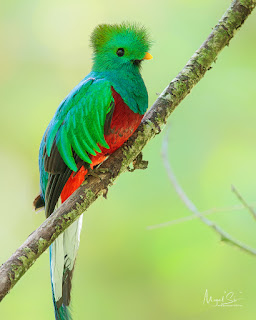For our final part of this series of posts we have selected what we consider the best bird we found at Pipeline Road, the male Black-throated Blue Warbler (Setophaga caerulescens).
This little songbird was observed by one of our friends while we were walking the Pipeline Road looking for an Agami Heron reported in on of the puddles beside the road, she was able to get a picture and we identified it as a Black-throated Blue Warbler. Birders that were in the area also saw it later, and immediately the word spread in the birding community, birders and photographers went to the place for an opportunity to observe this rare and beautiful migratory bird. Honestly, we never thought the bird was going to stay for more than a moment so we didn't spend energy chasing the bird. Warblers tend to be moving foragers, going rapidly from one place to another, you basically only see them passing by.
Luckily for all us, this bird seems to keep its wintering territory for days. After a couple of days when the "blue warbler fewer" went down, we returned to the place, and were able to stay all alone with the bird, and make all the shots we wanted, we became very close and personal as the picture above shows.
Habitat
This is a songbird of the deep forest in the northeastern United States and southeastern Canada, and breeds in mature deciduous and mixed coniferous-deciduous woodlands with a thick understory, often in hilly or mountainous terrain, winters in dense tropical forests, mainly in the Caribbean, on the islands and northern Central America, where it's seen in a variety of habitats, including forest, forest edges, parks, and gardens. Sexes use slightly different habitats. On migration the male is most common in forest at lower to mid-elevations, while the female uses shrubbier habitat at higher elevations. On the other hand, in Panama it's a very rare winter resident, found in lower levels of forest and woodland.
Behaviour
It's predominantly insectivorous, forages mostly in lower to mid-levels of forest, taking insects mostly from the underside of leaves, and supplements its diet with berries and seeds in winter.
Conservation status
The black-throated blue warbler has a large breeding range and a big population, which is considered to be currently increasing (listed as Least Concern). Disregarding this, deforestation and habitat fragmentation are threatening the black-throated blue warbler in its tropical wintering areas, as is happening with some other migratory warbler species.
Description
Besides being a bird of rare occurrence in our country, the male of the species is gorgeous. His back, tail, and top of head are blue-gray. Face and throat black. Black extending in line down sides to flanks. White below. Base of primaries white, showing as a large white patch in flight, but a small white spot near the edge of the wing when folded. Outer tail feathers with large white spots and black tips. Females are not as colourful, and resembles the plain Tennessee warbler but the black-throated blue warbler has white wing spots.
In the end we enjoyed observing this bird foraging in the shrubs and taking insects and seeds from the road itself. He repeated the whole behaviour a couple of times, covering the area in circles. We remained in the place for a couple of rounds as always, following the bird, trying to get the best shots without disturbing or stressing the bird. Then, we showed the bird to another person that arrived, and she was able to observe and photograph the bird while we were leaving. The following day, more people went to see the bird but it was not observed any more. We were at the right time in the right place, another important reason to select the Pipeline Road as the best place of 2015 for Panama Birds and Wildlife Photos.
-End of the Pipeline Road 2015 report.








Comments
Post a Comment